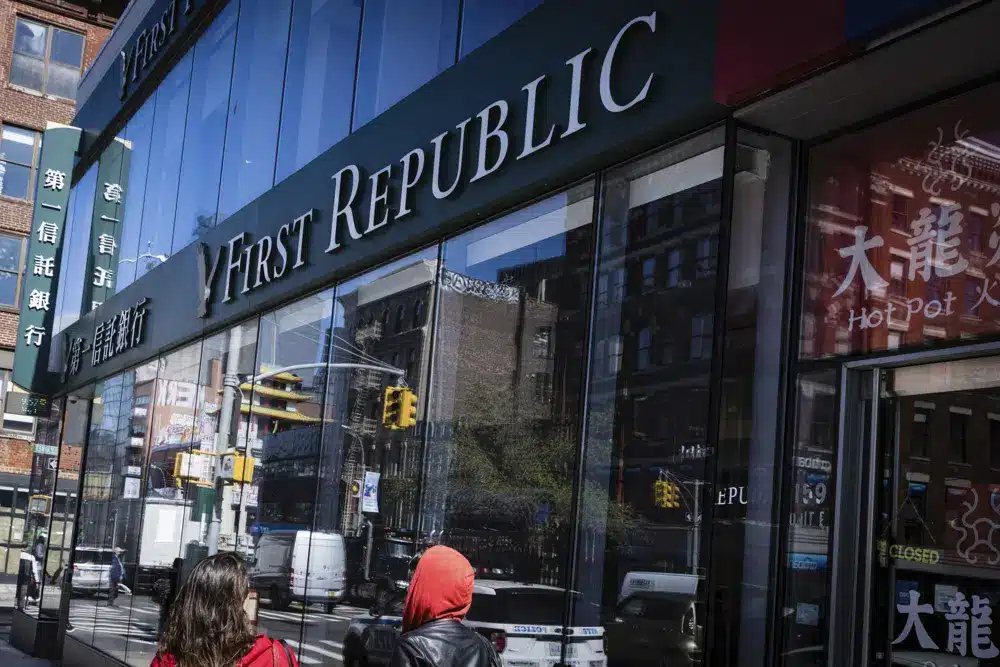Cryptocurrency
2023: First Republic Bank Seized, Sold In Fire Sale To JPMorgan

NEW YORK (Reuters) – Regulators seized insolvent First Republic Bank early Monday, making it the second-largest bank failure in US history, and immediately sold all of its deposits and most of its assets to JPMorgan Chase to resolve the upheaval that has raised concerns about the soundness of the US banking system.
It is the third midsize bank to go under in less than two months. The only larger bank failure in US history was Washington Mutual, which went bankrupt at the height of the 2008 financial crisis and was taken over by JPMorgan in a similar government-managed deal.
“Our government invited us and others to step up, and we did,” JPMorgan Chase Chairman and CEO Jamie Dimon said.
JPMorgan Chase took over First Republic’s 84 locations on Monday, acquiring the bank’s $92 billion in deposits and $203 billion in loans and other instruments. The bank’s stockholders are expected to be wiped out as part of the sale.
In a conference call with reporters and investors, Dimon stated that “this part of this (banking) crisis is over.” Other midsize banks reported their results last week, and the vast majority of them showed that deposits had stabilized and profits remained healthy. The First Republic was an outlier.
Before this year, First Republic was the banking industry’s envy. Its opulent branches provided warm cookies to its clients, who were nearly entirely wealthy and powerful. Its bankers enticed wealthy clients with low-cost mortgages and appealing savings rates to sell them on higher-profit ventures such as wealth management and brokerage accounts. In exchange, the wealthy rarely defaulted on their loans and deposited large sums of money in banks that could be borrowed elsewhere.
However, with Silicon Valley Bank’s and Signature Bank’s failures, that business model of catering to the wealthy became a liability. These banks had many uninsured deposits or deposits that exceeded the FDIC’s $250,000 limit. Clients with big accounts at First Republic, like those at Silicon Valley Bank and Signature Bank, quickly withdrew their funds at the first sign of problems.
In a note to investors, Timothy Coffey, an analyst with Janney Montgomery Scott, stated, “Too many (First Republic) customers demonstrated their true loyalties were to their fears.”
Last month, a group of a dozen banks put together a $30 billion funding package for the First Republic, which appeared to stop the bleeding of deposits for a time. However, it became clear that the First Republic needed more time: it needed to find a buyer or find new sources of funding to replace the deposits that had left the bank.
The First Republic intended to liquidate underperforming assets, such as low-interest mortgages supplied to rich clients. It also disclosed plans to lay off up to a quarter of its workers, estimated to be over 7,200 in late 2022. Analysts, though, saw it as too little, too late. For weeks, the bank appeared to be on the verge of failing.
According to Jeremy Barnum, JPMorgan’s chief financial officer, the $30 billion deal “bought time when time was needed” for the First Republic.
Last Monday, First Republic reported its first-quarter results, shocking analysts and investors by revealing that $100 billion in deposits had flowed out of the bank, most of which occurred in mid-March, immediately following the failures of Silicon Valley Bank and Signature Bank. During an earnings conference call, its executives took no questions from analysts. The stock of First Republic dropped by more than 50% the next day.
By the middle of last week, it was evident that the government needed to intervene in the First Republic. Treasury officials requested that banks submit bids for the First Republic, and bankers and regulators worked all weekend to find a solution.
JPMorgan is so large that it would be illegal to buy the First Republic.
JPMorgan Chase, the nation’s largest bank and a dealmaker in times of crisis, was once again the government’s go-to bank. Last month, Treasury officials appointed JPMorgan to head the $30 billion rescue package. Dimon was Washington’s go-to banker 2008 to find private solutions to the banking crisis, and JPMorgan acquired both Bear Stearns and Washington Mutual.
The Federal Reserve and FDIC, which, together with the Office of the Comptroller of the Currency, govern the banking industry, may face greater scrutiny for their management of First Republic. Both admitted in separate studies on Friday that inadequate supervision contributed to Silicon Valley Bank’s and Signature Bank’s failures.
“When interest rates were low, these banks were allowed to grow too big too fast,” Coffey explained in an interview.
There may now be concerns about JPMorgan Chase’s size, which has more than $3 trillion in assets and is by far the largest of the “too big to fail” firms worldwide.
Regulators “allowed the country’s largest bank to grow even larger.” “We expect this to be a Democratic focus for months,” said TD Cowen banking analyst Jaret Seiberg.
JPMorgan is so large that it would be illegal to buy the First Republic since no bank in the United States can have more than a 10% market share of deposits. JPMorgan was only able to step in because the First Republic failed.
JPMorgan described the First Republic transaction as favorable to the financial system and the company statement. As part of the arrangement, the FDIC will share losses on First Republic’s loans with JPMorgan. The FDIC estimates that First Republic’s failure will cost the insurance fund approximately $13 billion, which bank assessments rather than taxpayers pay.
JPMorgan anticipates First Republic to increase its net income by $500 million yearly, but it expects to incur $2 billion in costs integrating First Republic into its operations over the next 18 months.
SOURCE – (AP)
Cryptocurrency
Connor McDavid Wins Conn Smythe As Playoff MVP Despite Oilers Losing Stanley Cup Final To Panthers

SUNRISE, Florida – Connor McDavid earned the Conn Smythe Trophy as playoff MVP on Monday night, despite Edmonton’s Stanley Cup Final loss to Florida, in recognition of one of the best postseason performances in NHL history.
Despite being kept scoreless in the final two games, McDavid topped all postseason scorers with 42 points, five shy of Wayne Gretzky’s record of 47 set in 1985. He did not return from the locker room to receive the trophy from Commissioner Gary Bettman, leaving it on the stand while the Panthers celebrated nearby.
McDavid | AP News image
Connor McDavid Wins Conn Smythe As Playoff MVP Despite Oilers Losing Stanley Cup Final To Panthers
“It’s an honor with the names on that trophy, but yeah,” McDavid said.
McDavid placed first on 16 of 17 ballots. Panthers captain Aleksander Barkov finished second.
“I don’t think he cares,” longtime running mate Leon Draisaitl stated. “I mean, that shows how great of a hockey player he is. No player in the world wants to win the Stanley Cup more than him. He does everything properly every day, hoping to win one day. It’s incredibly hard because he’s unhappy and disappointed at the end.”
After going scoreless (but leading the team with three assists) in the first three games against Florida, McDavid shifted the course of the series by doing something no other player in history, including Gretzky, has done. He scored four points in two straight games in the finals to keep the Oilers from being eliminated.
“You think about the year that Connor had: 100 assists, leading our team, the performance he had in this playoffs, especially in this final round when we’re down three games to zero and then he comes out with eight points in two games,” the coach, Kris Knoblauch, said. “Yeah, he’s our leader, he’s our best player.”
After Flyers’ Reggie Leach in 1976, McDavid is only the second player to win the Conn Smythe on a team that lost in the final. Goaltenders Jean-Sebastien Giguere of Anaheim in 2003, Ron Hextall of Philadelphia in 1987, Glenn Hall of St. Louis in 1968, and Roger Crozier of Detroit in 1966 were also named playoff MVPs after backing up teams that fell short of winning the Cup.
Mcdavid | AP News Image
Connor McDavid Wins Conn Smythe As Playoff MVP Despite Oilers Losing Stanley Cup Final To Panthers
When asked how he was feeling over half an hour after the loss, McDavid could only say, “It sucks.”
McDavid, the reigning and three-time Hart Trophy winner widely regarded as the best hockey player in the world, put on a display in his maiden trip to the final. His goal and three helpers in an 8-1 victory in Game 4 prevented a sweep, and his four points, including an empty netter in Game 5 three nights later, returned the series to Alberta.
Those who know McDavid feel that his year-round effort throughout his career has helped him thrive when the spotlight shines brightest.
“He’s unique in his dedication to his craft,” said Hall of Famer Ken Hitchcock, McDavid’s coach in 2018-19. “He’s quite distinctive. He’s learned to be persistent, and he enjoys it. He’s really passionate about his craft, and that’s contagious when you’re on the same squad as him.”
Oilers teammates praised McDavid for setting a good example on and off the ice.
Mcdavid | AP News Image
Connor McDavid Wins Conn Smythe As Playoff MVP Despite Oilers Losing Stanley Cup Final To Panthers
“He’s the greatest player to ever play, in my opinion,” Draisaitl added. “There are so many things that he does that most people don’t notice, such as his work ethic. He almost singlehandedly turned our franchise around. I just love sharing the ice with him. He’s just a very remarkable person.”
That discussion is warranted for a player who led the league in scoring five times during the regular season and did almost everything on his own. What is still missing from the Stanley Cup, which will have to wait at least another year?
“Connor McDavid, he’s going to win the Stanley Cup someday,” said Patric Hornqvist, a two-time champion with the Pittsburgh Penguins who is now a Panthers scouting and development consultant. “That’s how good he is.”
SOURCE – (AP)
Cryptocurrency
How to Buy XEM P2b: Manage Your Finances and Returns

How do I buy XEM P2b? Blockchain and cryptocurrencies enable people to take control of their money in an ever-evolving financial landscape. XEM, the native digital asset of the New Economy Movement (NEM) blockchain network, is one such asset that enables users to have total financial control, manage an effective portfolio, and optimize high profits.
Let’s dig deep into the world of XEM and learn how to buy XEM P2B.
What is XEM P2B?
XEM is a digital asset created for the NEW network, which is based on economic freedom, decentralization, and equality. Furthermore, the platform is designed to manage assets and data efficiently and affordably.
XEM P2B is an acronym for New Economy Movement Platform to Business, and it is responsible for quickly processing business-to-business transactions. The breakthrough blockchain network has various characteristics to fulfill the needs of contemporary businesses, including scalability, security, and interoperability.
The platform streamlines the interchange of products and services while providing companies with future-proof and adaptable solutions. New technology, robust community support, smart alliances, and the ability to work with new technology make the platform an outstanding alternative for investors and traders.
Reasons for Buy XEM P2B
The crypto industry offers several platforms and digital assets for transactions, trades, and investments, but XEM P2B is successful owing to its practical qualities. A couple of the main characteristics are as follows:
Passive income opportunity: Participating in staking and network consensus enables investors to generate passive income. Individuals must stake in the XEM cryptocurrency to obtain rewards while encouraging a sustainable growth strategy.
Access to developing markets: Besides passive income and awards, the platform gives users access to emerging markets. Investing in the corresponding token closes the gap between the global and unbanked economies.
Top-notch security: The platform meets one of the most fundamental needs of businesses: security. XEM P2B prioritizes security by implementing an encryption protocol, proactive risk management strategies, and auditing methods.
XEM P2B also excels in regulatory compliance and governance, ecosystem growth, innovative creation, and market volatility hedging. The team behind the NEM platform is constantly working on new features, apps, and solutions for Decentralized Finance (DeFi) protocols and cross-border payments.
Furthermore, coordination with key companies and strategic partnerships in the cryptocurrency sector boosts the platform’s ecosystem. It also provides very quick transactions using the Proof-of-Importance (POI) method. The platform supports transaction speeds of up to 4K per second.
How do I buy XEM p2b?
After learning about the advantages and characteristics of buy XEM P2B, one should be interested in purchasing it. A few simple actions may help someone become an XEM holder. Here are several ways to buy XEM P2B directly from other users:
Platform selection: The first step in purchasing is to research and pick a renowned and dependable P2B platform. Individuals may evaluate platforms based on security features, costs, and payment options. LocalBitcoins, Binance P2P, and Hodl are other possibilities to consider.
Account opening: Once completed, the next step is establishing an account on the site and completing the KYC process. Meeting the standards provides security and transparency in the trading environment.
Offers Browsing: Users may browse available offers to purchase, sell, or exchange the native token. Price comparison, payment choices, and user reputations help you make the best decision.
Transaction initiation: After picking an appropriate offer, the next step is to begin a transaction with the seller. Fulfilling the agreed-upon conditions will assist both parties in commencing the transaction. The platform holds the money until the criteria are met.
Transaction completion: The last step is to complete the transaction by following the platform’s instructions. XEM is released to the user’s wallet after selecting a payment method and confirming the transaction.
Conclusion
Investing and trading in the XEM cryptocurrency enhances the portfolio, allows for better financial management, and generates passive income. Individuals may buy XEM P2B using LocalBitcoins, Binance P2B, and Hodl. Furthermore, the NEM blockchain provides superior security, rapid transactions, and access to new markets.
FAQs
What is the maximum supply of the XEM cryptocurrency?
The token’s maximum supply is 8,999,999,999 XEM.
Where can I get XEM P2B?
Individuals may trade XEM on Localbitcoins, Binance P2B, and Hodl.
More Related: DevelopSearcher.site: Improve Your Process of Development!
Cryptocurrency
ICO Crypto Token Launch Pads: Revolutionizing Crypto Fundraising and Investment

Overview of the ICO Crypto Token Launch Pads
An Initial Coin Offering (ICO) is the cryptocurrency industry’s version of an Initial Public Offering (IPO). Enterprises can raise cash to develop new cryptocurrency blockchain applications or services. Investors can participate in an ICO by purchasing the firm’s newly minted cryptocurrency, which may have utility related to the product or service or represent a share in the company. Notably, most ICOs are classified as security offerings and must comply with registration regulations.
Importance of ICO Launch Pad in the Cryptocurrency Business
ICO Crypto Launch Pads play an important part in the cryptocurrency sector. They act as platforms, facilitating the token issuance process for new projects. Launch Pads offer a standardized framework for executing ICOs, assuring regulatory compliance and increasing investor protection. These platforms serve as a conduit between companies and prospective investors, providing a safe and transparent environment for token offers.
Key advantages of employing a Launch Pad for token offerings:
Using an ICO Launch Pad benefits both project founders and investors. Launch Pads offer project creators access to a large investor base, increased credibility, and expedited token distribution processes. Launch Pads also provide investors with a selected selection of ideas, lowering the danger of fraud and allowing for early participation in promising ventures.
Furthermore, Launch Pads frequently include extra support services such as marketing, legal advice, and community building, increasing the likelihood of project success.
2. Key Components of an ICO Crypto Token Launch Pad
Project Selection Criteria for Launch Pads
ICO Launch Pads often use strict project screening criteria to ensure that only high-quality, legitimate projects are published on their platforms. These criteria could include the project team’s experience, the proposal’s validity, commercial potential, and technological innovation. Due diligence is carried out to reduce the danger of fraudulent or poorly designed projects.
Token distribution systems and processes.
Launch Pads play an important function in the token distribution process. They facilitate the issuance, sale, and allocation of tokens to investors. Launch Pads may use a variety of distribution mechanisms, including a fixed-price sale, a Dutch auction, or a tiered sales system. These procedures are intended to ensure fair and efficient token distribution while increasing the project’s fundraising potential.
The Function of Smart Contracts at ICO Launch Pads
Smart contracts, powered by blockchain technology, are critical components of ICO Launch Pads. They automate the token sale process, making it transparent, immutable, and secure. Smart contracts also allow for the automatic execution of predefined rules and circumstances, such as token distribution, vesting periods, and locking mechanisms. Launch Pads uses smart contracts to increase trust and eliminate the need for intermediaries in the token sale process.
3. Assessing ICO Projects on the Launch Pad
Due diligence procedure for evaluating ICO projects
ICO Launch Pads do extensive due diligence to determine the quality and legitimacy of projects they wish to list on their platforms. This process includes a thorough evaluation of the project team’s competence, the project’s business strategy, technical feasibility, and legal and regulatory compliance.
In addition, Launch Pads may seek external audits or expert opinions to verify a project’s claims and potential.
Risk assessment and mitigating measures
Launch Pads use rigorous risk assessment frameworks to identify and minimize hazards connected with the listed projects. These frameworks assess market, technical, regulatory, and operational risks. Launch Pads seeks to safeguard investors from fraudulent or failing initiatives while also promoting the long-term viability of the crypto ecosystem through rigorous risk assessments.
Ensure openness and credibility in ICO listings.
Transparency and credibility are important aspects of ICO launchpads. These platforms are designed to provide investors with credible and accurate information about listed projects. Launch Pads provide critical project information, such as the white paper, team profiles, fundraising targets, and token economics.
They also encourage open communication between project teams and the community, which promotes confidence and openness throughout the token sale process.
4. Maximizing Success in Launching Tokens through ICO Launch Pad
Marketing tactics to attract investors
To ensure the success of token releases, ICO Launch Pads use smart marketing methods. These techniques include social media campaigns, influencer collaborations, targeted advertising, and community involvement. Launch Pads also helps project founders develop a strong brand and communicate their value proposition to potential investors.
Developing a robust community around the token.
Community building is critical to the long-term viability of ICO ventures. ICO Launch Pads promote project teams’ interaction with the audience by providing regular updates, AMA (Ask Me Anything) sessions, and online forums. Launch pads frequently assist in organizing community events and encouraging active involvement. A strong and engaged community boosts the project’s legitimacy and increases the token’s liquidity and adoption rate.
After-launch token management and value proposition
ICO Launch Pads assist project teams in properly managing their tokens once the token sale has concluded. They facilitate the complicated terrain of cryptocurrency exchanges, liquidity provision, and token price stability. Furthermore, Launch Pads promotes continued communication between project teams and investors, providing transparency and regular updates on project progress. This post-launch support enables project teams to preserve investor confidence while delivering on their promised value offer.
5. FAQs
How can I take part in an ICO Crypto coin launch pad?
To participate in an ICO Crypto token launch pad, investors must first register an account on the relevant site. After completing the Know Your Customer (KYC) criteria, investors can browse the listed projects, study their details, and participate in token sales by following the Launch Pad’s instructions.
What are the advantages of releasing a token using an ICO Crypto platform?
Launching a token on the ICO Crypto platform provides several advantages, including access to a large pool of potential investors, increased credibility thanks to the platform’s due diligence process, streamlined token distribution mechanisms, and ongoing support services such as marketing and community engagement.
Are there any legal criteria to follow before establishing an ICO Crypto token?
There are legal procedures to consider when establishing an ICO Crypto token. The regulatory landscape differs by location, and project creators must follow applicable securities and banking legislation. Engaging legal counsel is critical for ensuring compliance and avoiding legal risks.
How can I guarantee the safety of my investment in an ICO Crypto token launch pad?
To safeguard the security of their investments in an ICO crypto token launch pad, investors should undertake extensive research and due diligence on the platform and the businesses featured on it. It is critical to assess the platform’s security procedures, including multi-factor authentication, secure fund storage, and smart contract audits. Furthermore, investors should be cautious and only invest what they can afford to lose.
In conclusion, ICO Crypto Token Launch Pads have transformed how cryptocurrency projects raise funding and interact with investors. These platforms offer a controlled and secure environment for launching tokens, increasing transparency and investor protection. ICO Launch Pads assist to the crypto industry’s long-term growth by adhering to rigorous project selection criteria, utilizing smart contract technology, doing due diligence, and encouraging community interaction.
-
World2 weeks ago
Former President Trump Survives Being Shot at Pennsylvania Rally
-
Tech4 weeks ago
Huawei Launches 5G-A Pioneers Program at MWC Shanghai 2024: Paving the Way for a Connected Future
-
Sports4 weeks ago
NBA Draft: Kyle Filipowski Withdraws Unexpectedly From The First Round
-
Tech4 weeks ago
ChatGPT Answers Undiscovered Questions and Outperforms Students.
-
News4 weeks ago
US Supreme Court Rejects Drug Deal that Protects the Sackler Family
-
Business4 weeks ago
Free Speech And Digital Rights Groups Argue TikTok Law Would Infringe On The First Amendment



















